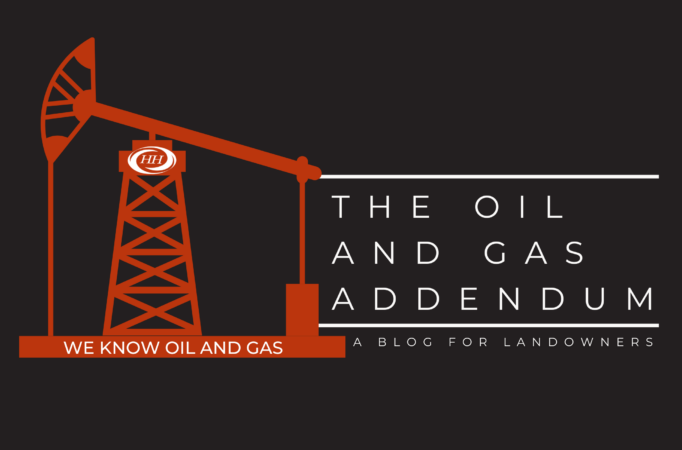The Oil and Gas Addendum
Pore Space Ownership: The North Dakota Supreme Court Issues Landmark Decision
Let's assume you own a 93-acre farm in Tioga County. In 1986 your grandfather sold the oil and gas rights to his neighbor, John Mize. In the early 1990's, Mr. Mize signed an oil and gas lease with XYZ Drilling. Several years later, XYZ Drilling completed a shallow gas well. This well-produced gas for a couple of years but ceased production in 1999 and the lease was surrendered. The oil and gas remain unleased.
In August 2022, an agent from Dioxide Storage Company ("DSC") calls you about entering into a "pore space" lease. You have no idea what he is talking about. The gentleman explains that DSC is the carbon capture business and they are taking new leases with landowners so they can drill and operate carbon injection wells. These wells will be used to "inject" captured carbon emissions into the rock formations beneath your farm. The economic terms are quite attractive and you are pleasantly surprised with this sudden leasing opportunity.
The next week, as you are prepared to sign the pore space lease, you are contacted by one of the Mize heirs. He says that since the Mize Family still owns the underlying oil and gas, they also control the pore space. He claims that you have no right or authority to lease the pore space. He also asserts that he intends to drill and operate his own carbon injection well on your farm. The agent for DSC tells you that the Mize Family is simply wrong: the surface owner controls the pore space. You .are now frustrated, confused and concerned. Who is correct? Who controls the pore space? Can the Mize Family drill and operate a carbon injection well without your consent? A recent decision by the North Dakota Supreme Court illuminates the complexity and uncertainty of pore space ownership and development. As carbon capture and sequestration continues to gain national traction, landowners in Pennsylvania should closely monitor this rapidly evolving issue as it most certainly will impact thousands of landowners.
At issue in the Northwest Landowners Association v. State of North Dakota, et al, 978 N.W. 2d 679 (N.D. 2022).was a statute known as Senate Bill 2344 ("S.B. 2344") which essentially authorized oil and gas operators to utilize pore space without owner compensation or consent. S.B. 2344 did this in three ways. First, it authorized unrestricted and unlimited use of pore space by operators and simultaneously prohibited landowners from demanding "payment for use of the subsurface geologic formation." See, N.D.C.C. §38-08-25. Second, S.B. 2344 amended the North Dakota Oil and Gas Protection Damage Compensation Act ("the "Damages Act") by specifically excluding pore space from the statutory definition of "Land". See, N.D.C.C. §38-11.1-01. The Damages Act requires operators to compensate landowners for lost "land value" caused by drilling operations. By excluding pore space from the definition of "Land", S.B. 2344 essentially eliminated the need for operators to procure and negotiate pore space leases with landowners. Third, S.B. 2344 barred tort claims altogether for the injection, migration and storage of substances into the landowner's pore space. Advocates of S.B. 2344 argued that the bill was critical to the emerging carbon sequestration industry in North Dakota and that it was in "the public interest to promote the use of carbon dioxide to benefit the State."
The North Dakota Senate passed S.B. 2344 on April 16, 2019 and Governor Doug Burgum signed the bill into law on April 18, 2019. At the time he signed S.B. 2344 into law, Governor Burgum exclaimed that S.B. 2344 created "certainty for underground injection, which has the potential to enhance oil recovery and further improve the environmental sustainability of North Dakota's coal industry." Not everyone agreed. Several months later, the Northwest Landowners Association (the "Association") filed an action challenging the constitutionality of S.B. 2344. The Association argued that S.B. 2344 constituted an unconstitutional taking of private property because it "stripped landowners of their right to possess and use pore space" and allowed others to use the pore space "without consent or compensation."
To appreciate the significance of the Northwest Landowners Association v. State of North Dakota litigation, a brief review of the interplay between carbon sequestration and underground storage is warranted. Carbon sequestration refers to the process by which carbon emissions are captured prior to discharge into the atmosphere. The captured carbon, however, must be stored somewhere safe and for a very long time. That is where underground storage comes into play- the captured carbon must be injected into the rock formations thousands of feet below the surface. Where does the injected carbon actually go? Into the proverbial "pore space".
Pore space is generally described as the empty space or cavity between layers or grains of rock. 1 It is most often associated with depleted oil and gas reservoirs. In other words, once the oil or gas is drained and extracted from an underground reservoir, what remains is a geologic void ( i.e., the space formerly filled by the hydrocarbons). This void is known as the pore space.
Who owns the pore space? There are two schools of thought. Under the so-called "American Rule", the owner of the surface estate generally owns and controls the pore space. This is the majority position in the United States. See, Burlington Resources Oil & Gas Company, LP v. Lang and Sons Incorporated, 259 P.3d 766 (Mont. 2021) ("...pore space beneath the property belongs to the surface estate ..."); Southern Natural Gas Company v. Sutton, 406 So. 2d 669 (La. Ct. App. 1981) ("...surface ownership, however, includes the right to use the reservoir underlying the land for storage purposes"); Department of Transportation v. Goike, 560 N.W. 2d 365 (Mich. Ct. App. 1996) ("the storage space, once it has been evacuated of minerals and gas, belongs to the surface owner"); Mosser v. Denbury Resources, Inc.,898 N.W.2d 406 (N.D. 2017) ("...we agree with the interpretations by the federal magistrate judge and the federal district court judge that pore space is part of the surface owner's interest..."); Emeny v. United States, 412 F.2d 1319 (Ct. Cl. 1969) (owner of the surface owns the "geological structures beneath the surface, including any such structures that might be suitable for the underground storage of foreign or extraneous gas"); See also, WYOMING STAT § 34-1- l 52(A) ("[T]he ownership of all pore space in all strata below the surface lands and water of this state is declared to be vested in the several owners of the surface above the strata"). The minority view is known as the "English Rule." Under this approach, the owner of the mineral estate and/or the lessee controls the pore space. See, Hammonds v. Central Kentucky Natural Gas Co., 75 SW 2d 204 (Ky. Ct. App. 1934) (overruled Texas American Energy Corp. v. Citizens Fidelity Bank & Trust Co., 736 SW 2d 25 (Ky. 1987)). Prior to the enactment of S.B. 2344, North Dakota generally followed the American Rule. However, S.B. 2344 unilaterally changed and de-valued such ownership rights.
In Northwest Landowners Association v. State of North Dakota, the Association argued that by precluding any compensation for pore space usage and further excluding pore space from the definition of "Land" under the Damages Act, S.B. 2344 effectively rendered the pore space worthless. This reduction in value, the Association contended, amounted to an unconstitutional "taking" of private property under the United States and North Dakota Constitutions. As such, the Association requested that S.B. 2344 be struck down in its entirety given the wholesale elimination of pore space as a distinct and independent property interest. In essence, the Association argued that if a surface owner cannot exclude a third-party from accessing and using the pore space, then the pore space itself no longer has any real or intrinsic value. The district court agreed and granted the Association's motion for summary judgment. The State of North Dakota appealed to the North Dakota Supreme Court.
On appeal, the North Dakota Supreme Court made two critical findings: i) ownership of the pore space, like any other real property interest, necessarily includes the right and privilege to exclude others; and ii) the injection of gas or other substances into the pore space constitutes a physical occupation of that property interest. Because S.B. 2344 sanctioned physical occupation of pore space without any compensation, the North Dakota Supreme Court declared that section of S.B. 2344 an unconstitutional taking of private property:
By prohibiting the right to compensation for use of the surface owner's pore space and eliminating the right to exclude, S.B. 2344 removes all rights that make ownership of pore space valuable. Furthermore, although the use of pore space may not seriously interfere with a landowner's use of the rest of his land because the pore space is deep beneath the surface, Loretto held that compensation is required for physical invasions even if the owner suffers only a "minimal economic impact." 458 U.S. at 434-35. Therefore, because S.B. 2344 deprives surface owners from demanding compensation for physical occupation of their property, S.B. 2344 is an unconstitutional taking on its face in violation of the state and federal constitutions.
The decision in Northwest Landowners Association v. State of North Dakota is significant for several reasons. First, it affirms pore space ownership as a distinct and independent property interest that is entitled to broad constitutional protection. Second, it recognizes that the owner of the pore space is entitled to compensation for pore space usage. This generally means that operators who want to inject captured carbon emissions into pore space must first obtain the pore space owner's consent and must pay reasonable compensation for such physical occupation of the pore space. In practical terms, this means that operators will need to negotiate and procure pore space leases with the appropriate owners. Finally, the court recognized that the unauthorized injection of fluid or gas into the pore space, or the migration of the same from nearby injection wells, could constitute an actionable subsurface trespass. As other jurisdictions, including Pennsylvania, wrestle with pore space ownership and development, the Northwest Landowners Association v. State of North Dakota decision will provide much-needed clarity and guidance in addressing similar issues.
1 North Dakota defines pore space as "a cavity or void, whether natural or artificially created, in a subsurface sedimentary stratum." See, N.D.C.C. §47-31-02.
About Us
Oil and gas development can present unique and complex issues that can be intimidating and challenging. At Houston Harbaugh, P.C., our oil and gas practice is dedicated to protecting the interests of landowners and royalty owners. From new lease negotiations to title disputes to royalty litigation, we can help. Whether you have two acres in Washington County or 5,000 acres in Lycoming County, our dedication and commitment remains the same.
We Represent Landowners in All Aspects of Oil and Gas Law
The oil and gas attorneys at Houston Harbaugh have broad experience in a wide array of oil and gas matters, and they have made it their mission to protect and preserve the landowner’s interests in matters that include:
- New lease negotiations
- Pipeline right-of-way negotiations
- Surface access agreements
- Royalty audits
- Tax and estate planning
- Lease expiration claims
- Curative title litigation
- Water contamination claims

Robert Burnett - Practice Chair
Robert’s practice is exclusively devoted to the representation of landowners and royalty owners in oil and gas matters. Robert is the Chair of the Houston Harbaugh’s Oil & Gas Practice Group and represents landowners and royalty owners in a wide array of oil and gas matters throughout the Commonwealth of Pennsylvania. Robert assists landowners and royalty owners in the negotiation of new oil and gas leases as well as modifications to existing leases. Robert also negotiates surface use agreements and pipeline right-of-way agreements on behalf of landowners. Robert also advises and counsels clients on complex lease development and expiration issues, including the impact and effect of delay rental and shut-in clauses, as well as the implied covenants to develop and market oil and gas. Robert also represents landowners and royalty owners in disputes arising out of the calculation of production royalties and the deduction of post-production costs. Robert also assists landowners with oil and gas title issues and develops strategies to resolve and cure such title deficiencies. Robert also advises clients on the interplay between oil and gas leases and solar leases and assists clients throughout Pennsylvania in negotiating solar leases.

Brendan A. O'Donnell
Brendan O’Donnell is a highly qualified and experienced attorney in the Oil and Gas Law practice. He also practices in our Environmental and Energy Practice. Brendan represents landowners and royalty owners in a wide variety of matters, including litigation and trial work, and in the preparation and negotiation of:
- Leases
- Pipeline right of way agreements
- Surface use agreements
- Oil, gas and mineral conveyances

